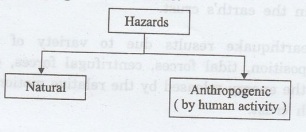Physics For Civil Engineering: Unit V: Natural Disasters
Types of hazards
Certain natural phenomena produce environmental disequilibrium or disaster or hazards causing large-scale destruction of human life and property.
Unit - V
Natural Disasters
Seismology
and Seismic waves Earth quake ground motion Basic concepts and estimation
techniques - site effects Probabilistic and deterministic Seismic hazard
analysis Cyclone and flood hazards - Fire hazards and fire protection,
fire-proofing of materials, fire safety regulations and fire fighting equipment
- Prevention and safety measures.
Introduction
Certain
natural phenomena produce environmental disequilibrium or disaster or hazards
causing large-scale destruction of human life and property. These hazards are
accidental, and mostly, humans do not play a significant role in these.
However,
some times, human activities accelerate the process. Hazard management is an
important issue that needs serious consideration.
Some of the hazards which cause
environmental degradation are earth-quakes, cyclones, landslides, drought,
famines, etc.
The
magnitude and frequency of these processes depend on factors such as climate,
geology, vegetation, and human activities.
Types
of hazards
Hazards
are classified into two types:
(i)
Natural hazards
(ii)
Anthropogenic hazards.

Natural hazards
• Air-related hazards: Hurricanes,
cyclones, storms, etc.
•
Water-related hazards: Floods, droughts, etc.
•
Earth-related hazards: Earthquakes, landslides, volcanoes, etc.
Anthropogenic hazards
•
Industrial accidents
• War, riots, acts of terrorism, etc.
•
Toxic spills
Some of the hazards, their causes,
effects, and management techniques are discussed in the following sections.
Physics For Civil Engineering: Unit V: Natural Disasters : Tag: : - Types of hazards
Related Topics
Related Subjects
Physics for Civil Engineering
PH3201 2021 Regulation | 2nd Semester Civil Dept 2021 Regulation
